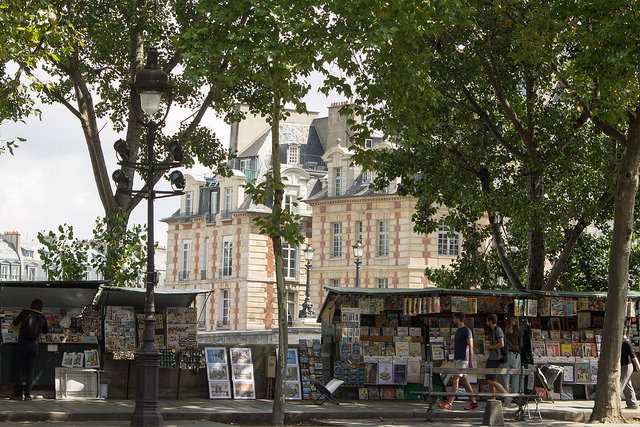Strolling the banks of the Seine in Paris is a grand affair. The impressive architecture of the Musee d’Orsay overlooks the water; the iconic towers of the Notre Dame poke skywards in the distance; lovers sip wine with their feet dangling over the ledges; and wicker-chaired cafes, with their decorative awnings, stud the length of it.

The bouquinistes in paris (Photo: Ninara via Flickr)
As I flicked through vintage map after vintage map in the dark corner of a green shelter, I could have been anywhere in the world. My back turned on the landmarks of Paris, my mind a million miles a way.
You see, it wasn’t the Gothic spires or the lazy café lifestyle that charmed me along the river banks. It was the rudimentary cart-like stalls set up along the Seine that drew me in. The bouquinistes, as they’re known.
The bouquinistes aren’t your typical souvenir stop-off, touting tiny toy Eiffel Towers or beret after beret. Far from it. These stalls are a bastion of Parisian culture and have remained a stalwart part of the city for hundreds of years. Selling everything from old postcards, watercolour paintings, and vintage books with peeling front covers, to handmade goods and old naval maps, the bouquinistes sucked me into a world without WiFi.
For stall owners, the deal is just as sweet. With virtually no overheads to pay, they can flog books at low prices and still earn a decent income. But today they are a far cry from the thieving merchants that started the phenomenon back in the 1500s.

The bouquinistes sell vintage books and paintings (Photo: Carles Tomas Marti via Flickr)
It’s thought that the bouquinistes came to life after a ship transporting books sunk near the cathedral, giving free reign to the sailors who swam ashore with armfuls of goods to sell to passers-by (after all, their promised wages had sunk with the ship).
The spontaneous trade-off proved to be a hit, so the sailors and merchants began bargaining for books throughout the city to sell on the streets. Although from then on the bouquinistes were an important part of local life, it hasn’t always been such an easy ride. In 1557, the merchants were accused of selling protestant pamphlets during the Wars of Religion (which were forbidden at the time), and even today they face barriers that might see a centuries-old trend become extinct in the next few years.
In the shadow of the internet, where visitors can download any book with the click of a button, the bouquinistes are heading towards a rocky future. Though I flicked through the vintage maps like I was in search of pirate treasure, I knew that the tiny, technological device in my pocket could get me anywhere I wanted to go. I knew that I could look up the old book that caught my eye and read it for cheaper without having its broken spine clogging up my bookcase. Even though I’m an avid believer in the good old-fashioned book, I don’t always practice what I preach – and the bouquinistes are falling prey to this mentality.

A close up of the vintage books in the Bouquinistes (Photo: Fabien Lemetayer via Flickr)
In light of their dwindling trade, the merchants must hunt for cheaper books in sales, flea markets, and house clearances. To earn a decent living they have to bid themselves into the ground to outwit the internet, and they’ve turned to flogging a few tourist gadgets here and there just to make ends meet. This doesn’t mean they’re turning into the tacky souvenir shops that surround the Eiffel Tower. Only one of the four boxes that each merchant is assigned can be used to sell anything other than books, with key chains and magnets sitting snug beside beautiful oil paintings and gold-trimmed books.
Though times are seemingly tough, the bouquinistes are still going strong – a hint at the determined nature of Paris’ oldest traditions. Today, they span almost 3 kilometres, from the Quai du Louvre to Pont Marie and from the Quai Voltaire to the Quai de la Tournelle. And despite their impending doom thanks to the internet, wannabe merchants aren’t put off by the challenge. In fact, the waiting time to join the bouquinistes is 8 years.
I find myself wondering what kind of technology-clad world the future bouquinistes will serve, and what alterations they’ll have to put in place to be able to make a decent living, and I wonder what the merchants of the past would have thought if they could still see the bouquinistes going strong today.

The bouquinistes sit against the grand buildings of Paris (Photo: BikerNormand via Flickr)
For me, a stroll along this literary-inspired length of the Seine was a flight from reality, as I thumbed through old magazines and black and white photographs. When I turned back around to face the sights of Paris that I’d actually come to see – the Notre Dame, the Musee d’Orsay, and the sidewalk café culture – the sun was beginning to set and the bouquinistes were packing up for the day. Maps were folded, spinning postcard racks were disassembled and tucked away, and the books were flushed into darkness as the lids of the shelters were padlocked for the night.
Each closed green box suddenly looked insignificant against the grand architecture of Paris and the twinkling lights over the Seine, but I knew that each and every one of them held hundreds of stories that spanned hundreds of years.
The next day I rushed back to purchase a vintage map. Yes, Google can get me anywhere I want to go with the click of a button, but nothing quite beats the feel of paper between my fingers and the stories that the unassuming map has been a part of.